History
The bishopric of Ampurias, also known as Diocese of Flumen ('the stream' in Latin), was founded circa 1170, like the Diocese of Gallura (later renamed Civita), plausibly when Pope Alexander II reorganized the ecclesiastical jurisdictions of Sardinia, which was being temporally divided into four autonomous giudicati ('judgedoms'), corresponding to the administrative curatorial of Anglona in the Giudicato of Torres, as suffragan of the Metropolitan Archdiocese of Torres.
Its original episcopal see, Amurias, was an Ancient port town, presumably at the coast of Codaruìna near Valledoria by the bay of Coghinas. Its original cathedral was dedicatated to the Apostle Peter, (now?) called San Pietro Mare ('Saint Peter by the Sea').
The first historically recorded Bishop of Ampurias, Bono, had a part around 1100 in the foundation of the monastery of San Nicolò di Solio, one of many founded in the diocese by the Cassinese Benedictine Congregation in the 11th and 12th centuries, thirteen of which depended on Santa Maria di Tergu; whether their possessions ware exempt from the episcopal authority remained a matter of continuous dispute, giving to several papal interventions in favor of the Benedictines, possibly culminating in the murder of the abbot of Santa Maria di Tergu shortly before 1203.
According to the Rationes decimarum (mid 14th century), the diocese comprised 21 plebanies and rectories (parishes). The town of Ampurias faded with its port due to the sand-clogged bay of Coghinas, so in the 14th century the episcopal see was effectively transferred (without title change) to Castelgenovese (now Castelsardo), formalized in 1503 when Pope Julius II elevated the Benedictine priory of Sant'Antonio into the new diocesan cathedral, which presently remains co-cathedral in the successor bishopric.
From 1506, the see of Ampurias was held in personal union (aeque principaliter) with the Diocese of Civita, until they merged effectively on 1986.09.30, both formally being suppressed in favor of the (present) Diocese of Tempio–Ampurias (with cathedral see at Tempio Pausania, in former Civita) as suffragan of the Metropolitan Archdiocese of Sassari.

Tempio Pausania is a town of about 14,000 inhabitants in the Gallura region of northern Sardinia, Italy, in the province of Sassari. It is one of I Borghi più belli d'Italia.

Olbia is a city and commune of 60,346 inhabitants in the Italian insular province of Sassari in northeastern Sardinia, Italy, in the historical region of Gallura. Called Olbia in the Roman age, Civita in the Middle Ages and the Terranova Pausania until the 1940s, Olbia has again been the official name of the city since the fascist period.

Gallura is a region in North-Eastern Sardinia, Italy.

The Archdiocese of Sassari is a Latin archdiocese of the Catholic Church in Sardinia, Italy. Its see was initially at Torres. It was elevated to an archdiocese in 1073.

Oschiri is a comune (municipality) and former bishopric in the Province of Sassari in the Italian region Sardinia, located about 170 kilometres (110 mi) north of Cagliari and about 40 kilometres (25 mi) southwest of Olbia.

The Diocese of Saluzzo is a Latin diocese of the Catholic Church in the Piedmont region of northwestern Italy, centered in the comune of Saluzzo. The diocese was established on 29 October 1511 for political reasons, to transform the Marquisate of Saluzzo into an ecclesiastic territory, and was directly dependent upon the Holy See. It is now a suffragan of the Archdiocese of Turin.

The Diocese of Concordia-Pordenone is a Latin diocese of the Catholic Church situated in northeastern Italy, at the northern end of the Adriatic Sea, between Venice and Udine. Since 1818, Concordia Veneta, has been a suffragan of the Archdiocese of Venice. Bishop Andrea Casasola attended the Provincial Council of the Provincia Veneta in October 1859 as a suffragan of the Patriarch of Venice, Cardinal Giuseppe Luigi Trevisanato. The name of the diocese was changed to its present form in 1971.

The Diocese of Biella is a Latin diocese of the Catholic Church in northern Italy, in the Piedmont region. The diocese was established in 1772. It is a suffragan of the Archdiocese of Vercelli. Biella is a city in Piedmont, 42km northwest of Vercelli.

The Diocese of Pitigliano-Sovana-Orbetello is a Latin Church diocese of the Catholic Church in the ecclesiastical province of the Metropolitan Archdiocese of Siena-Colle di Val d'Elsa-Montalcino, in Tuscany. The diocese of Sovana had originally been directly dependent upon the Holy See, and its bishops attended the pope's synods. When Pope Pius II, who was a Piccolomini of Siena, created the metropolitan archdiocese of Siena, he made Sovana one of its suffragan dioceses. The bishops of Sovana usually resided in the former palace of the Orsini in Pitigliano, which was given to Bishop Francesco Pio Santi (1776–1789) by the Grand Duke of Tuscany.

The Diocese of Tempio-Ampurias is a Latin Church diocese of the Catholic Church in Sardinia, Italy. Until 1986 it was known as Diocese of Ampurias e Tempio. It is a suffragan of the Archdiocese of Sassari
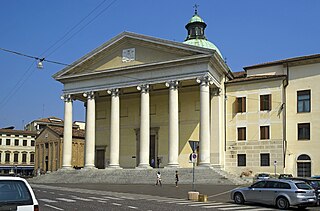
The Diocese of Treviso is Latin Church ecclesiastical territory or diocese of the Catholic Church in the Veneto, Italy. It is a suffragan diocese in the ecclesiastical province of the metropolitan Patriarchate of Venice.
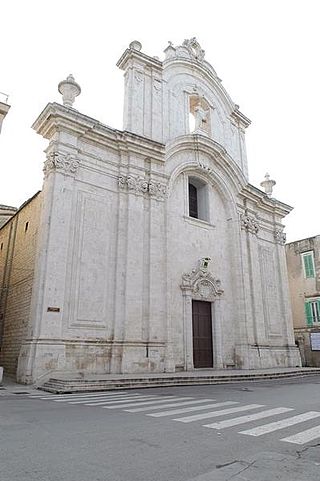
The Diocese of Molfetta-Ruvo-Giovinazzo-Terlizzi is a Latin diocese of the Catholic Church in Apulia, southern Italy, which was established in 1986, when the diocese of Molfetta-Giovinazzo-Terlizzi was united with the diocese of Ruvo. Giovinazzo is only four miles south-east of Molfetta along the Adriatic coast, and Ruvo only ten miles inland to the south-west; Terlizzi is likewise only four miles from Molfetta, some four miles nearer than Ruvo. The historical diocese of Molfetta was expanded in 1818. The current diocese is a suffragan of the archdiocese of Bari-Bitonto.
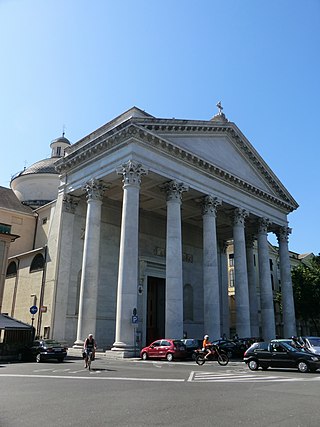
The Diocese of Chiavari is a Latin diocese of the Catholic Church in Liguria, northern Italy. It was created on 3 December 1892 by Pope Leo XIII in the Bull Romani Pontifices. It is a suffragan of the Archdiocese of Genoa.
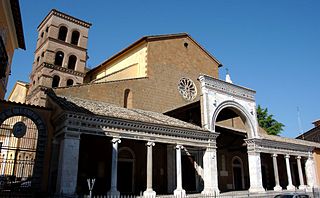
The Diocese of Civita Castellana is a Latin Church ecclesiastical territory or diocese of the Catholic Church in Latium, central Italy. It has existed in the current form since 1986, when the Diocese of Nepi e Sutri was united into the Diocese of Civita Castellana, Orte e Gallese. The Diocese of Gallese had been added to the Dioceses of Civita Castellana and Orte in 1805. The name of the diocese was shortened in 1991, in accordance with Vatican policies. The diocese of Civita Castellana is immediately exempt to the Holy See.

The Diocese of Massa Carrara-Pontremoli is a Latin diocese of the Catholic Church situated in north-western Tuscany, in the valley of the Frigido River. The city of Massa is on the south side of the river, 5 km from the Tyrrhenian Sea. The city of Carrara is 6 km north of Massa, on the Carrione River. The diocese is a suffragan of the Archdiocese of Pisa.

The Diocese of Ozieri s a Latin Church diocese of the Catholic Church in Sardinia, Italy. It is a suffragan of the Metropolitan Archdiocese of Sassari.
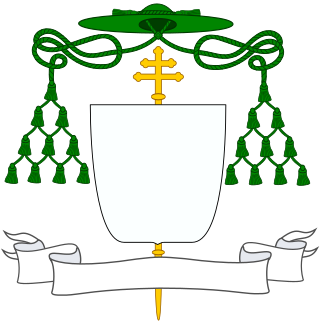
Ottorino Pietro Alberti was an Italian Roman Catholic archbishop who served as Archbishop of Cagliari from 1987 to 2003.
The Roman Catholic Diocese of Civita(-Tempio) was a Latin Catholic bishopric in the Gallura region of northern Sardinia.

The Sardinian Romanesque is the Romanesque architectural style that developed in Sardinia. The Romanesque architecture in Sardinia has had a remarkable development since the early origins, during the Giudicati era, and for a long period. His expressions, although autonomous, are not classifiable in a recognizable image, since in the island the Romanesque manifested itself with unusual results but in numerous forms; this is due to the establishment in Sardinia of several religious orders, coming from various Italian regions and from France. Consequently, in the architectures of that era Pisan, Lombard and Provençal influences are recognizable as well as traces of the passage of workers, coming from the Iberian Peninsula, of Islamic culture.

Lu Bagnu is a hamlet of 1664. inhabitants of the municipality of Castelsardo, in Sassari province.


















